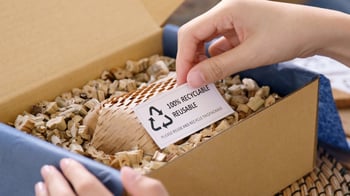Managing returns has traditionally been treated as an afterthought. But with the rise in eCommerce sales, returns are sure to be substantial, which can lead to a poor customer experience and revenue losses. Many businesses are now placing more emphasis on handling returns, called the reverse logistics process. And some initiatives have come a long way. Here’s what those look like and what we might expect from the future of reverse logistics.
What is Reverse Logistics?
If logistics describes how products move through the supply chain from warehouses to consumers, reverse logistics details how things move in the opposite direction. In other words, it deals with products going from the customer back to the supplier for a number of reasons:
- Broken or damaged products
- Mistakes made in order fulfillment
- Customers changing their mind
- Product recalls
- Trade-in or recycling programs
The reverse logistics process works by authorizing a product return, assessing product condition upon receipt, reclaiming any product value (adding it back to inventory, selling at a discount, etc.), and approving any customer refunds.
Why Reverse Logistics Should Be a Priority
With the rise of online sales, reverse logistics have become a major factor in doing business. In fact, the average eCommerce return rate ranges between 20-30%. According to Statista, returns of online merchandise in the U.S. alone amounted to nearly $213 billion in 2022. That’s a decrease of about 2% from the prior year, likely due to more businesses focusing on reverse logistics.
 It’s tough to discuss online sales without also addressing returns. eCommerce giants like Amazon have set the bar high by offering free, no-hassle returns to customers. This “Amazon Effect” means that many consumers are searching for similar experiences. In fact, over three-quarters of consumers will decline to do business with an online seller that doesn’t have a reasonable return policy.
It’s tough to discuss online sales without also addressing returns. eCommerce giants like Amazon have set the bar high by offering free, no-hassle returns to customers. This “Amazon Effect” means that many consumers are searching for similar experiences. In fact, over three-quarters of consumers will decline to do business with an online seller that doesn’t have a reasonable return policy.
In addition to delivering a positive customer experience, making reverse logistics a priority just makes good business sense. When your company can efficiently repurpose returned goods, this can save what would otherwise be lost revenue. Also, a well-run reverse logistics process delivers valuable insights you can use to improve your business.
The Future of Reverse Logistics
According to Grandview Research, the reverse logistics market was worth about $840.7 billion in 2021. From 2022 to 2028, this figure is expected to expand by a compound annual growth rate (CAGR) of about 12.4%.
The rising awareness among companies of the benefits of reverse logistics will continue to fuel growth and innovation in this area. And many of the innovations that are improving supply chain and warehouse efficiencies can also apply to reverse logistics. Here are a few of the things you can expect to see in reverse logistics in the coming years.
Using RFID Solutions
 Without a robust reverse logistics plan in place, businesses would be unable to keep up with the volume of eCommerce returns. Fortunately, the same technology solutions that improve efficiency in the forward supply chain can help maximize processes and efficiency in reverse logistics.
Without a robust reverse logistics plan in place, businesses would be unable to keep up with the volume of eCommerce returns. Fortunately, the same technology solutions that improve efficiency in the forward supply chain can help maximize processes and efficiency in reverse logistics.
RFID, or radio frequency identification, is a technology that is beginning to replace traditional barcodes. Unlike barcodes, which must be read individually and only hold limited data, RFID tags can be read automatically as products move in either direction. They can also communicate more comprehensive data, such as product descriptions, dates, temperature, and more. Using RFID can simplify the reverse logistics process and save costs. It also provides a better customer experience as consumers want to be able to track their purchases and returns in real time.
Leveraging Blockchain Technology
Blockchain technology has the potential to revolutionize reverse logistics. It’s a decentralized digital ledger that records transactions without errors. It is a transparent and secure means of tracking the movement of returned products, better enabling businesses to manage their returns and recycling or disposal processes.
Many businesses have yet to embrace blockchain. But that could change as the benefits of this technology become more clear. These include:
- Improved traceability — Using blockchain, businesses can create digital record histories for each product and show their movement through the supply chain.
- Increased efficiency — By using blockchain technology to automate certain parts of the reverse logistics process, you can reduce the time and cost of managing returns.
- Enhanced asset utilization — Blockchain technology can enable the reuse of returned products, which reduces waste and boosts asset utilization.
- Better transparency — Because blockchain technology creates a decentralized, transparent transaction record, it makes it easier to track the movement of products through the reverse logistics process.
Focusing on Data-Driven Forecasting
Making the most of things like RFID and blockchain requires embracing digital technology solutions throughout the supply chain. Things like a warehouse management system can help a business automate its processes and inject more visibility throughout the supply chain.
Improved transparency allows businesses to adapt quickly to changes and optimize costs. If a large percentage of certain products are being returned due to defects or some other issue, this is something the business can address. Using an inventory management system to its full capabilities can save labor hours and reduce inventory carrying costs.
Embracing Sustainability
 Today and in the future, more merchants will focus on sustainability as a way to differentiate their business and be better environmental stewards. Shoppers, particularly Gen Z, want to support these types of brands. When choosing which products to buy, 80% of customers will weigh sustainability in their decision, and one-third are willing to pay more for sustainable products.
Today and in the future, more merchants will focus on sustainability as a way to differentiate their business and be better environmental stewards. Shoppers, particularly Gen Z, want to support these types of brands. When choosing which products to buy, 80% of customers will weigh sustainability in their decision, and one-third are willing to pay more for sustainable products.
But, in addition to focusing on how products are made and fulfilled, your business should also take a look at sustainable reverse logistics. Analyze your returns process to see how it can be more environmentally friendly. Can you reuse packaging with returns? Instead of sending items to the landfill, can they be sold at a discount? If they are unusable, see if they can be recycled or repurposed.
One of the main factors in supply chain management is logistics. But instead of simply focusing on getting products into customers’ hands, businesses must also figure out how to efficiently handle returns. As reverse logistics take a more critical role in your organization, you’ll find that customers are more satisfied, and you achieve better overall results.
About the Author:
In 2005, Newcastle Systems, Inc. was the first U.S. company to introduce mobile powered industrial carts to support supply chain applications, bringing leading-edge efficiencies to the market. The company has continuously pioneered new technology developing the first swappable lithium battery system for industrial applications in 2016, as well as the most ergonomic mobile carts available. A privately-owned, Massachusetts-based company, it serves some of the largest retailers, manufacturers, and distributors in the world to help to increase supply chain efficiency by consistently doubling employee productivity while reducing costly labeling errors by over 92%.











